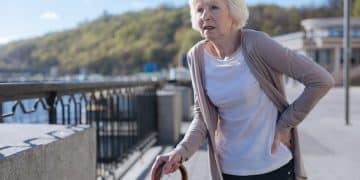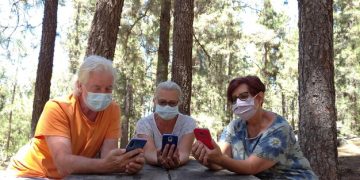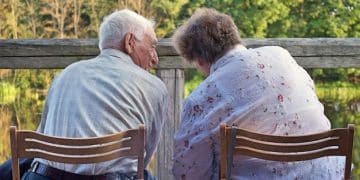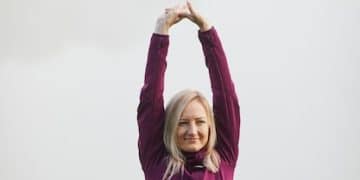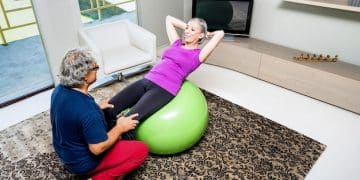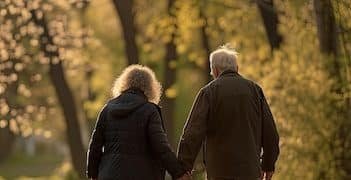Reduce Fall Risk 30% Seniors: 2025 Home Safety
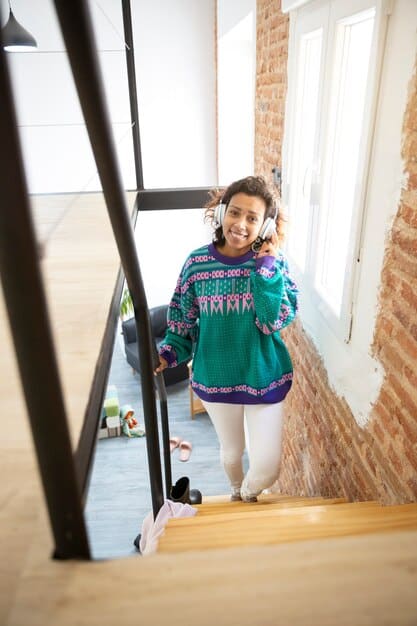
Updated home safety assessments in 2025 are crucial for seniors, providing targeted interventions and modifications that can significantly reduce the risk of falls by up to 30%, fostering greater independence and well-being.
Understanding how can seniors reduce fall risk by 30% with updated home safety assessments in 2025 is paramount for maintaining independence and enhancing quality of life. This guide will explore the latest strategies and practical steps to transform living spaces into safer environments for older adults.
Understanding the Impact of Falls on Seniors
Falls represent a significant threat to the health and independence of older adults. Beyond the immediate physical injuries like fractures and head trauma, a fall can significantly diminish a senior’s confidence, leading to reduced activity levels and a decline in overall well-being. The fear of falling can be just as debilitating as the fall itself, often resulting in social isolation and a faster loss of functional independence. This psychological impact underscores the critical need for proactive prevention strategies.
The statistics are stark: falls are the leading cause of fatal injury and the most common cause of nonfatal trauma-related hospital admissions among older adults. In the United States alone, millions of seniors experience falls each year, leading to billions in healthcare costs. Each fall, whether minor or severe, often initiates a cascade of negative health outcomes, from prolonged recovery periods to increased reliance on caregivers. Therefore, addressing fall risk is not merely about preventing injuries, but about preserving autonomy and dignity.
The Multifaceted Nature of Fall Risk
Understanding why falls occur is the first step toward effective prevention. Fall risk is rarely attributable to a single factor but is instead a complex interplay of intrinsic and extrinsic elements. Intrinsic factors relate to an individual’s health and physical condition, while extrinsic factors involve the environment. A comprehensive home safety assessment aims to identify and mitigate these combined risks, turning potential hazards into safe pathways.
Common intrinsic risk factors include age-related changes in vision and balance, muscle weakness, chronic health conditions such as arthritis or Parkinson’s disease, and side effects from medications. Polypharmacy, the use of multiple medications, is a particularly insidious risk factor, as drug interactions can cause dizziness, drowsiness, or impaired coordination. Addressing these health-related issues often requires collaboration with healthcare providers, making fall prevention a holistic endeavor.
The Role of Home Environment in Fall Prevention
While an individual’s health plays a crucial part, the home environment is often where falls are most likely to occur. Uneven surfaces, poor lighting, cluttered pathways, and a lack of supportive aids can transform a familiar living space into a perilous obstacle course. Many falls happen within the home during routine activities, highlighting the need for a thorough and thoughtful assessment of the living space. Simple modifications can make a profound difference, transforming risk zones into safe havens.
This recognition emphasizes that fall prevention is not solely a medical issue but a design challenge. By systematically evaluating the physical layout of a home, identifying potential hazards, and implementing practical solutions, we can dramatically reduce the likelihood of falls. The focus in 2025 moves beyond basic fixes to a more integrated approach, considering the senior’s specific needs, daily routines, and evolving physical capabilities, ensuring that interventions are both effective and sustainable for the long term.
Key Components of an Updated Home Safety Assessment in 2025
The approach to home safety assessments for seniors in 2025 has become more refined, leveraging technology and a deeper understanding of human factors. It’s no longer just about removing clutter, but about creating an intelligent, adaptable living space. These assessments are personalized, focusing on the individual senior’s mobility, cognitive abilities, and daily habits, ensuring that interventions are tailored and effective. The goal is to move beyond mere compliance to proactive adaptation, anticipating future needs.
A comprehensive assessment typically involves a professional, such as an occupational therapist or a certified aging-in-place specialist, who can identify subtle hazards often overlooked by the homeowner. This professional expertise is critical in discerning risks that might not be immediately obvious, such as inadequate lighting or ill-placed rugs. Their trained eye can spot potential problem areas and recommend highly effective, evidence-based solutions that integrate seamlessly into the home environment, providing long-term safety benefits.
Lighting and Visibility Enhancements
Adequate lighting is perhaps one of the most cost-effective and immediate ways to prevent falls, yet it is frequently underestimated. In 2025, the focus extends beyond merely increasing light levels to optimizing lighting for clarity and reducing glare. This includes using smart lighting systems that can adjust intensity and color temperature based on time of day or occupancy, as well as task lighting in key areas such as kitchens and reading nooks.
- Smart Lighting Systems: Implement motion-activated lights in hallways, stairwells, and bathrooms, and consider smart bulbs that can be controlled via voice commands or apps, allowing for customizable lighting levels.
- Glare Reduction: Use matte finishes on floors and walls, and install blinds or curtains to manage natural light, preventing blinding glare that can obscure obstacles.
- Path Illumination: Ensure all pathways, especially between the bedroom and bathroom at night, are consistently and brightly lit, free from shadows.
Flooring and Surface Modifications
The type and condition of flooring play a pivotal role in fall prevention. Slippery surfaces, loose rugs, and uneven transitions are common culprits. In 2025, recommendations lean towards non-slip flooring materials and securing anything that could shift underfoot. Removing small, throw rugs is often the first step, replaced by wall-to-wall carpeting with low pile or non-slip area rugs that are securely taped down.
For hard surfaces like tile or wood, applying non-slip treatments can provide an invisible layer of protection. Special attention should be paid to areas prone to moisture, such as bathrooms and kitchens, where water can significantly increase the risk of slipping. Transition strips between different flooring types should be flush and clearly visible, preventing trips and stumbles. The ultimate aim is to create a consistently stable and secure walking surface throughout the entire home.
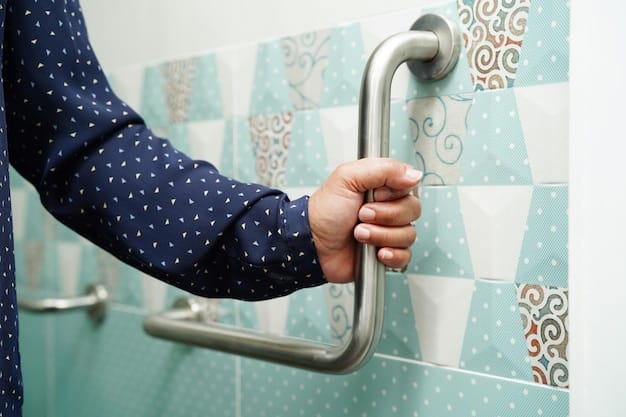
Essential Home Modifications for Fall Reduction
Beyond lighting and flooring, specific structural and practical modifications within the home are instrumental in preventing falls. These changes often target high-risk areas like bathrooms and staircases, providing crucial support and stability. The philosophy behind these modifications in 2025 is to integrate safety features seamlessly, preserving the aesthetics and comfort of the home while maximizing protection.
Bathroom Safety Updates
Bathrooms are notorious for falls due to wet, slippery surfaces and confined spaces. Essential updates include the installation of grab bars and the adaptation of shower and toilet areas. Grab bars, when properly installed by a professional, provide critical support for entering and exiting tubs/showers and using the toilet. Their placement should be strategic, considering the senior’s typical movements and needs.
- Grab Bars: Install sturdy grab bars in the shower/tub area and beside the toilet. Ensure they are professionally mounted into wall studs, not just anchored into drywall.
- Non-slip Surfaces: Use non-slip mats or apply non-slip strips inside the shower/tub and on the bathroom floor. Consider a walk-in shower or tub cut-out for easier access.
- Adjustable Shower Heads: A handheld showerhead allows for seated bathing, further reducing the risk of slipping while standing.
- Raised Toilet Seats: These can make sitting and standing easier, reducing strain and the likelihood of losing balance.
These modifications are not just about adding equipment; they are about redesigning the space to accommodate safer movements. For instance, replacing traditional shower doors with curtains can provide more maneuvering space, and ensuring adequate lighting in the bathroom is paramount, especially at night when quick trips are common.
Stairway and Pathway Security
Stairs present a significant fall hazard. Securing them involves a combination of structural checks, lighting improvements, and supportive aids. Handrails should be sturdy, extend the full length of the staircase on both sides, and be easy to grip. Contrast strips on steps can help define edges, especially for those with impaired vision. Clutter on stairs must be rigorously avoided.
- Handrails: Ensure well-secured handrails on both sides of staircases, extending beyond the first and last steps.
- Clear Pathways: Keep all hallways, staircases, and frequently used pathways entirely free of clutter, loose wires, and small furniture.
- Step Definition: Use contrasting colors or anti-slip strips on the edge of each step to improve visibility and traction.
- Adequate Lighting: Install bright, evenly distributed lighting over stairways, ideally with switches at both the top and bottom.
Beyond staircases, maintaining clear and unobstructed pathways throughout the home is fundamental. This includes furniture arrangement, electrical cords management, and ensuring sufficient space for mobility aids if used. Regular decluttering is an ongoing process that significantly contributes to a safer home environment, preventing trips over everyday objects that can easily be overlooked.
Leveraging Technology for Enhanced Fall Prevention in 2025
The year 2025 brings exciting advancements in technology that can significantly bolster fall prevention efforts. From smart home devices to wearable sensors, these innovations offer real-time monitoring, early warning systems, and improved responsiveness in case of a fall. Integrating technology into home safety assessments allows for a proactive and continuously evolving approach to protecting seniors, moving beyond static, one-time interventions.
Wearable Devices and Monitoring Systems
Wearable technology has evolved from simple fitness trackers to sophisticated medical alert systems that can detect falls automatically. These devices, often worn as pendants or wristbands, can signal for help if a fall occurs and the wearer is unable to do so themselves. Some advanced models even incorporate GPS tracking and vital sign monitoring, providing an additional layer of security and peace of mind for both seniors and their families.
- Automatic Fall Detection: Many modern medical alert devices can detect sudden changes in movement indicative of a fall, automatically alerting emergency contacts or monitoring centers.
- GPS Tracking: For seniors who spend time outdoors or live in larger homes, GPS capabilities can help locate them quickly if a fall occurs.
- Heart Rate & Activity Monitoring: Some wearables track daily activity levels and heart rate, which can provide insights into overall health and potential decline that might increase fall risk.
Beyond emergency response, these devices can also collect data on activity patterns, which can be useful for healthcare providers in assessing mobility trends and adjusting care plans. The discrete nature of many wearables means they can be integrated into daily life without feeling intrusive, offering continuous protection without inhibiting independence.
Smart Home Adaptations for Safety
Smart home technology offers a wide array of tools to create a safer and more responsive living environment. Automated lighting, smart sensors, and voice-activated controls can simplify daily tasks and reduce the need for risky movements. These systems can be particularly beneficial for seniors with mobility limitations or cognitive impairments, offering intuitive control over their surroundings.
- Voice-Activated Controls: Using smart speakers to control lights, thermostats, and even open blinds can reduce the need to reach or bend, minimizing fall risks.
- Motion-Sensing Lighting: Installing motion sensors in hallways and bathrooms ensures lights turn on automatically when someone enters, preventing falls in dark environments, especially at night.
- Smart Sensors and Alarms: Water leak detectors in bathrooms or kitchens can prevent slippery conditions, while smart door/window sensors can provide security and peace of mind.
The beauty of smart home technology lies in its adaptability. Systems can be customized to individual needs and preferences, and often expanded as new solutions become available. This integration creates an ecosystem of safety that supports daily living, making the home a more secure and comfortable place for seniors to age in place with confidence.
Professional Guidance and Ongoing Support
While many home safety modifications can be undertaken by homeowners, securing professional expertise significantly enhances the effectiveness of fall prevention strategies. In 2025, the emphasis is on a collaborative approach, involving healthcare professionals, aging-in-place specialists, and sometimes even technology consultants. This multidisciplinary strategy ensures that all aspects of fall risk, from physical health to environmental hazards, are comprehensively addressed, leading to more sustainable and impactful outcomes.
The Role of Occupational Therapists
Occupational therapists (OTs) are uniquely qualified to conduct comprehensive home safety assessments. Their training focuses on how individuals interact with their environment and how to adapt tasks or surroundings to improve functional independence. An OT can identify specific risks based on a senior’s mobility, strength, vision, and cognitive abilities, offering tailored recommendations that go beyond generic safety checklists.
- Personalized Assessment: OTs conduct thorough evaluations of a senior’s physical capabilities and daily routines within their home environment.
- Tailored Recommendations: They provide specific, actionable advice on modifications and adaptive equipment that are most relevant to the individual’s needs, maximizing efficacy.
- Training and Education: OTs can educate seniors and their caregivers on safe movement techniques, proper use of assistive devices, and strategies for managing daily activities to prevent falls.
The value of an OT lies in their holistic approach. They don’t just look for hazards; they assess how a senior moves through their home, identifying potential points of struggle and recommending solutions that fit seamlessly into their lifestyle. This personalized attention is critical for achieving that 30% reduction in fall risk, as it addresses the unique challenges each senior faces.
Regular Re-assessments and Adaptations
Home safety is not a one-time project. As seniors age, their physical and cognitive abilities can change, necessitating ongoing re-evaluations of their living environment. What was safe last year might not be safe this year. Therefore, regular re-assessments, ideally annually or whenever there’s a significant change in health status, are crucial to maintaining a high level of safety and adapting to evolving needs.
These re-assessments provide an opportunity to identify new hazards, adjust to any new mobility aids, or incorporate the latest technologies that can further enhance safety. They also allow for fine-tuning existing modifications, ensuring they continue to serve their purpose effectively. This continuous cycle of assessment, adaptation, and review ensures that the home remains a safe and supportive environment, empowering seniors to live independently for as long as possible.
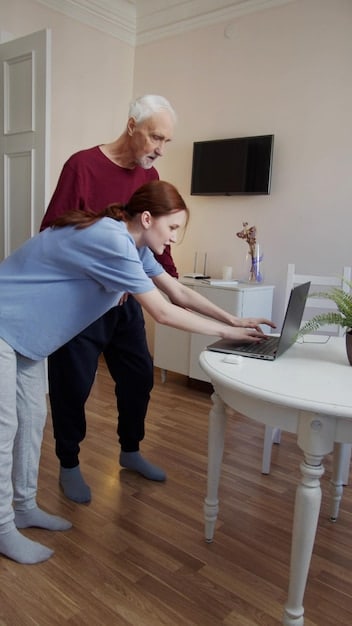
Empowering Seniors Through Education and Proactive Measures
Achieving a significant reduction in fall risk is not solely about modifying the physical environment; it also heavily relies on empowering seniors themselves through education and fostering a proactive mindset towards their own safety. Understanding personal risk factors and adopting safer behaviors are just as crucial as any structural modification. This holistic approach cultivates awareness and encourages active participation in maintaining a fall-free lifestyle, enabling lasting benefits.
Understanding Personal Risk Factors
For seniors, recognizing their own unique risk factors is the first step toward effective prevention. This involves understanding how certain health conditions, medications, or lifestyle choices might increase their susceptibility to falls. For example, knowing that a particular medication causes dizziness encourages extra caution when standing up quickly. Awareness empowers individuals to make informed decisions about their daily activities and seek appropriate medical advice when needed.
- Medication Review: Regularly discuss all medications, including over-the-counter drugs and supplements, with a doctor or pharmacist to identify potential side effects or interactions that might increase fall risk.
- Vision and Hearing Checks: Schedule annual eye exams and hearing tests, as impaired senses can significantly affect balance and awareness of surroundings.
- Physical Activity: Engage in regular exercise programs focused on improving balance, strength, and flexibility, such as tai chi, walking, or gentle resistance training.
This self-assessment and openness to medical review are foundational. Encouraging seniors to be active participants in managing their health, rather than passive recipients of care, significantly boosts the effectiveness of fall prevention strategies. It fosters a sense of control and responsibility, which are key to long-term success in reducing fall incidents.
Adopting Safe Habits and Routines
Beyond understanding risks, developing and consistently practicing safe habits within the home and during daily routines can prevent countless falls. These habits might seem minor individually, but cumulatively, they create a safety-conscious lifestyle. Simple changes in routine, like taking extra time to transition from sitting to standing, can make a significant difference in preventing loss of balance.
- Slow Transitions: Avoid rushing when getting out of bed, rising from a chair, or changing positions. Allow the body time to adjust, especially if prone to dizziness.
- Use Assistive Devices: If prescribed, consistently use canes, walkers, or other assistive devices, ensuring they are properly fitted and maintained.
- Footwear Choices: Wear supportive, non-skid shoes that fit well, even when indoors. Avoid walking in socks, bare feet, or loose slippers that offer poor traction.
- Carry Wisely: Avoid carrying too many items at once or carrying heavy loads that might obstruct vision or compromise balance, especially when navigating stairs.
These proactive measures are about cultivating a continuous awareness of potential hazards and adopting behaviors that minimize risk. When combined with a professionally assessed and modified home environment, fostering these habits can create a powerful synergy that helps seniors significantly reduce their fall risk and maintain their independence and well-being well into 2025 and beyond.
Future Outlook: Innovations in 2025 and Beyond
As we look beyond 2025, the landscape of fall prevention for seniors is set to evolve further, driven by rapid advancements in technology and a deeper understanding of geriatric care. Integrating artificial intelligence, predictive analytics, and personalized interventions promises an even more proactive and efficient approach to ensuring senior safety. The future envisions homes that not only react to fall risks but anticipate them, offering dynamic support.
AI and Predictive Analytics in Home Safety
Artificial intelligence (AI) is emerging as a powerful tool for identifying subtle changes in a senior’s gait, balance, or activity patterns that could signal an increased fall risk. AI-powered sensors in the home could track movement without requiring wearables, maintaining privacy while providing critical data. This data, combined with predictive analytics, could alert caregivers or healthcare providers to potential issues even before a fall occurs, enabling timely interventions.
- Passive Monitoring: Non-intrusive sensors can analyze movement patterns, sleep quality, and daily routines to detect deviations that may indicate declining mobility or health.
- Predictive Risk Assessment: AI algorithms can analyze aggregated data to predict an individual’s fall risk, allowing for proactive adjustments to care plans or home modifications.
- Personalized Interventions: AI can recommend highly personalized exercises or cognitive activities based on detected patterns, helping maintain or improve capabilities.
The goal is to create a dynamic feedback loop: continuous monitoring informs adaptive interventions, keeping pace with a senior’s changing needs. This futuristic approach aims to shift fall prevention from reactive to truly predictive, minimizing incidents and maximizing the senior’s quality of life.
Smart Materials and Adaptive Environments
Innovations in material science are also poised to revolutionize home safety. Imagine flooring that subtly adjusts its texture to provide more grip when moisture is detected, or furniture that automatically locks in place if it senses instability. Smart materials integrated into the home’s very fabric could offer a continuous, undetectable layer of protection, making safety an intrinsic part of the living environment.
- Responsive Flooring: Floors embedded with sensors and adaptive surfaces that can adjust traction based on conditions or gait.
- Integrated Support Systems: Walls with seamless, pull-out grab bars or hidden reinforcement for future installations.
- Adaptive Furniture: Chairs that gently assist with standing or beds that automatically adjust height for safer transfers.
These advancements promise to create truly intelligent homes that evolve with their inhabitants, providing flexible support as capabilities change. The vision is for environments that actively contribute to the well-being and independence of seniors, making fall prevention an invisible, integrated aspect of daily living, leading to substantial reductions in fall rates and fostering greater peace of mind for everyone involved.
| Key Point | Brief Description |
|---|---|
| 💡 Enhanced Lighting | Smart systems and optimized glare reduction prevent visual hazards. |
| 🏠 Home Modifications | Grab bars, non-slip surfaces, and clear pathways are crucial. |
| 📱 Tech Integration | Wearables, sensors, and smart home devices offer real-time safety. |
| 🧑⚕️ Professional Support | Occupational therapists ensure personalized, ongoing assessments. |
Frequently Asked Questions About Senior Fall Prevention
It is generally recommended to update a senior’s home safety assessment annually, or whenever there is a significant change in their health status. This ensures that the home environment continues to meet their evolving physical and cognitive needs, proactively addressing new potential hazards and maintaining optimal safety.
Smart home technology can significantly contribute to fall prevention beyond mere convenience. Features like motion-activated lighting in dark areas, voice-controlled devices, and smart sensors that detect changes in activity patterns can directly reduce fall risks by making the home environment more responsive and supportive for seniors.
While a multi-faceted approach is most effective, ensuring adequate and appropriate lighting throughout the home, especially in high-traffic areas and during nighttime hours, is often cited as the single most effective intervention. Good lighting significantly improves visibility, helping seniors navigate their environment more safely and identify potential obstacles.
Coverage for home safety assessments can vary. Medicare may cover occupational therapy services, which include home assessments, if deemed medically necessary by a doctor. It’s crucial to check with your specific insurance provider, as well as the healthcare professional conducting the assessment, to understand coverage details and any out-of-pocket costs.
Approaching the topic with empathy and focusing on maintaining independence and quality of life is key. Frame modifications as enhancements for comfort and practical solutions, rather than indicators of lost ability. Involving them in the decision-making process and perhaps starting with smaller, less intrusive changes can help them feel more in control.
Conclusion
The journey to understand and implement strategies for how seniors can reduce fall risk by 30% with updated home safety assessments in 2025 reveals a comprehensive approach that goes beyond simple fixes. By integrating professional assessments, targeted home modifications, and leveraging the latest technological advancements, we can create living environments that actively support the safety and independence of older adults. Empowering seniors through education and fostering proactive habits further solidifies these efforts, ensuring a future where the fear of falling is replaced by confidence and continued well-being.
